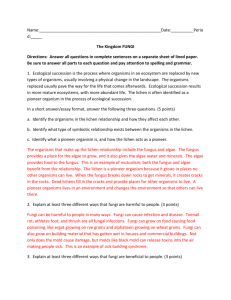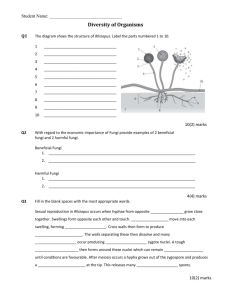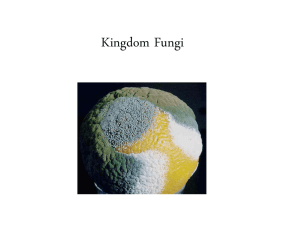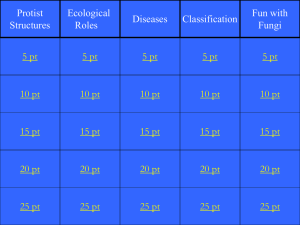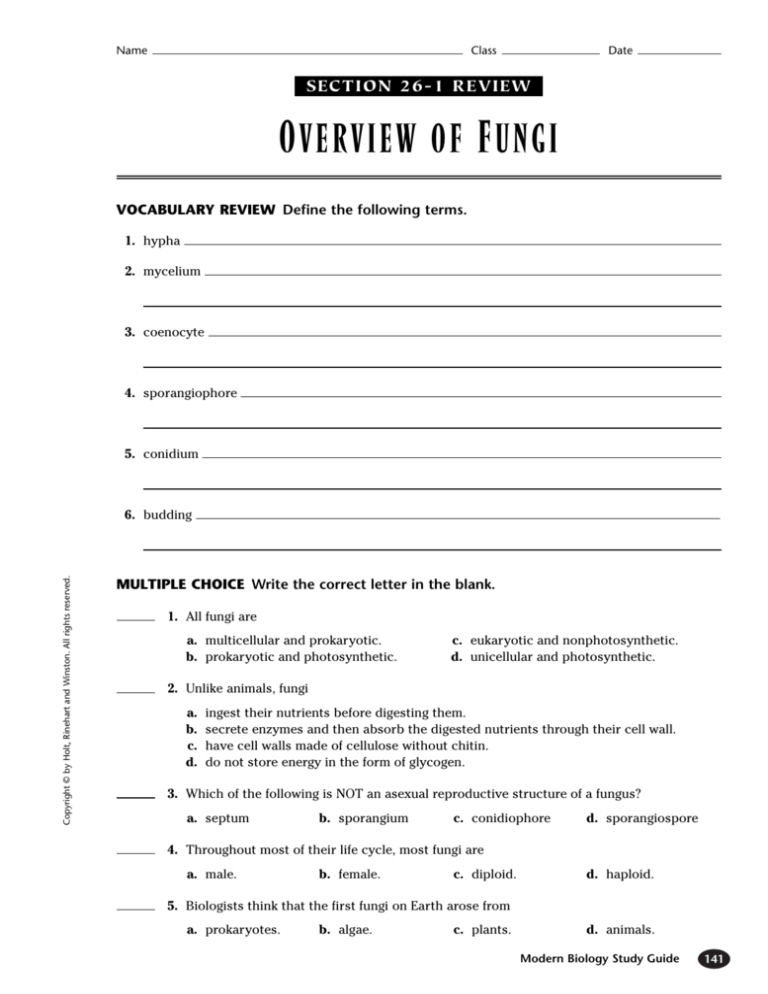
Name
Class
Date
SEC T I O N 2 6 - 1 R E VIEW
O VERVIEW OF F UNGI
VOCABULARY REVIEW Define the following terms.
1. hypha
2. mycelium
3. coenocyte
4. sporangiophore
5. conidium
Copyright © by Holt, Rinehart and Winston. All rights reserved.
6. budding
MULTIPLE CHOICE Write the correct letter in the blank.
1. All fungi are
a. multicellular and prokaryotic.
b. prokaryotic and photosynthetic.
c. eukaryotic and nonphotosynthetic.
d. unicellular and photosynthetic.
2. Unlike animals, fungi
a.
b.
c.
d.
ingest their nutrients before digesting them.
secrete enzymes and then absorb the digested nutrients through their cell wall.
have cell walls made of cellulose without chitin.
do not store energy in the form of glycogen.
3. Which of the following is NOT an asexual reproductive structure of a fungus?
a. septum
b. sporangium
c. conidiophore
d. sporangiospore
4. Throughout most of their life cycle, most fungi are
a. male.
b. female.
c. diploid.
d. haploid.
5. Biologists think that the first fungi on Earth arose from
a. prokaryotes.
b. algae.
c. plants.
d. animals.
Modern Biology Study Guide
141
Name
Class
Date
SHORT ANSWER Answer the questions in the space provided.
1. How do the cell walls of fungi differ from those of plants?
2. Describe an example of dimorphism in fungi.
3. Explain how a fungus reproduces through fragmentation.
4. What do “plus” and “minus” mean when used in reference to fungi?
5. What characteristic do fungi share with animals?
6. In what way are fungi resource recyclers?
7. Critical Thinking In what ways are most fungi similar to unicellular protists?
The drawings below depict two types of fungal hyphae.
a
b
d
142
Section 26-1 Review
c
e
Copyright © by Holt, Rinehart and Winston. All rights reserved.
STRUCTURES AND FUNCTIONS Identify the structures labeled a–c. In the spaces below
the drawings, name the type of hyphae each drawing represents.
Name
Class
Date
SEC T I O N 2 6 - 2 R E VIEW
C LASSIFICATION OF F UNGI
VOCABULARY REVIEW Distinguish between the terms in each of the following pairs
of terms.
1. rhizoid, stolon
2. basidium, basidiocarp
3. ascogonium, antheridium
4. ascocarp, ascus
Copyright © by Holt, Rinehart and Winston. All rights reserved.
5. lichen, mycorrhiza
MULTIPLE CHOICE Write the correct letter in the blank.
1. Fungi that have coenocytic hyphae and reproduce sexually through conjugation belong to
the phylum
a. Zygomycota.
b. Basidiomycota.
c. Ascomycota.
d. Deuteromycota.
c. zygosporangium.
d. basidiocarp.
2. A mushroom is an example of a
a. rhizoid.
b. ascogonium.
3. Fungi that produce spores inside saclike compartments belong to the phylum
a. Zygomycota.
b. Basidiomycota.
c. Ascomycota.
d. Deuteromycota.
4. In the life cycle of an ascomycete, haploid nuclei fuse when
a.
b.
c.
d.
conidia germinate.
asci develop.
a tube forms between the ascogonium and the antheridium.
ascospores germinate.
5. One of the functions of the fungus in a mycorrhizal relationship is to
a. perform photosynthesis
b. store sugars for the plant.
c. absorb phosphate and other ions.
d. decompose rock to form soil.
Modern Biology Study Guide
143
Name
Class
Date
SHORT ANSWER Answer the questions in the space provided.
1. How do the above-ground, sexual reproductive structures of basidiomycetes differ in appearance
from those of ascomycetes?
2. How are fungi imperfecti different from other fungi?
3. Explain the difference between a mycorrhiza and a lichen.
4. What effect do lichens have on their physical environment?
5. Explain why mushrooms cannot be grouped with deuteromycetes.
6. What would be more beneficial to a growing plant, a mycorrhiza or lichen? Explain your answer.
they form?
STRUCTURES AND FUNCTIONS Label each structure or process in the spaces provided.
The diagram below illustrates asexual and sexual reproduction in zygomycetes.
a
b
f
Germination
e
c
d
144
Section 26-2 Review
Copyright © by Holt, Rinehart and Winston. All rights reserved.
7. Critical Thinking Why are fungi classified according to the sexual reproductive structures
Name
Class
Date
SEC T I O N 2 6 - 3 R E VIEW
F UNGI AND H UMANS
VOCABULARY REVIEW Answer the questions in the space provided.
1. What are aflatoxins?
2. What effect do aflatoxins have on humans?
3. Where are the organisms that produce aflatoxins found?
4. What is a wheat rust?
MULTIPLE CHOICE Write the correct letter in the blank.
1. Sniffling, sneezing, and respiratory distress may be symptoms of an allergic reaction to
a. cortisone.
b. the Amanita mushroom.
c. the yeast Candida albicans.
d. mold spores.
2. Which of the following is not a condition or disease that can be caused by fungi?
Copyright © by Holt, Rinehart and Winston. All rights reserved.
a. athlete’s foot
b. AIDS
c. ringworm
d. candidiasis
3. Fungal diseases that affect human internal organs are often caused by
a. dimorphic fungi.
b. deuteromycetes.
c. truffles.
d. morels.
4. The yeast Saccharomyces cerevisiae is used to make all of the following except
a. bread.
b. vaccines.
c. ethanol.
d. penicillin.
5. Fungi of the genus Cephalosporium are used to produce
a. mushrooms.
b. cheese.
c. antibiotics.
d. soy products.
6. Which of the following is not a fungal product of importance to the food-processing
industry?
a. vitamin B2
b. wheat rust
c. citric acid
d. gluconic acid
7. The automobile fuel gasohol is made in part with
a.
b.
c.
d.
aflatoxins produced by Amanita.
gluconic acid produced by Saccharomyces cerevisiae.
ethanol produced by yeast.
citric acid produced by yeast.
Modern Biology Study Guide
145
Name
Class
Date
SHORT ANSWER Answer the questions in the space provided.
1. What conditions can cause Candida albicans to flourish?
2. Name four specific medical products that are produced by or with the use of fungi.
3. Name four types of foods that are produced by or with the use of fungi.
4. How is Saccharomyces cerevisiae induced to manufacture substances that it does not
normally make?
5. Critical Thinking Some fungi produce substances with attractive odors or flavors. These
substances are often concentrated in the reproductive structures of the fungi. Why might it be
adaptive for a fungus to produce such substances?
a
can produce foods
such as
b
c
d
Fungi
can produce nonfood
items such as
e
f
g
can cause disease
through mechanisms
such as
h
i
146
Section 26-3 Review
Copyright © by Holt, Rinehart and Winston. All rights reserved.
STRUCTURES AND FUNCTIONS This flowchart illustrates the effects that fungi can have
on humans. Fill in the blanks to complete the chart.
3. Chemotaxis in slime molds is the ability to crawl
toward AMP. Human leukocytes also exhibit
chemotaxis. By studying slime molds, scientists
hope to better understand how leukocytes protect
against disease.
4. The toxins from dinoflagellates concentrate as
they move up the food chain. Clams and oysters
eat the algae, and humans eat the shellfish.
STRUCTURES AND FUNCTIONS
a. sporozoites; b. sporozoites; c. liver; d. merozoites;
e. red blood cells; f. gametocytes
Section 26-1
VOCABULARY REVIEW
1. A hypha is a fungal filament.
2. A mycelium is a mat of hyphae visible to the
unaided eye.
3. A coenocyte is a species that has hyphae lacking
septa.
4. A sporangiophore is a specialized hypha that
looks like an upright stalk and bears a sporeforming sac.
5. A conidium is a fungal spore that is formed without the protection of an enclosing sac.
6. Budding is an asexual process in which part of a
yeast cell pinches itself off to produce a small
offspring cell.
MULTIPLE CHOICE
1. c
2. b
3. a
4. d
5. a
STRUCTURES AND FUNCTIONS
a, septum; b, nuclei; c, cell wall; d, septate hyphae;
e, coenocytic hyphae
Section 26-2
VOCABULARY REVIEW
1. A rhizoid is a zygomycete hypha that penetrates the
surface on which the fungus is growing; a stolon is a
zygomycete hypha that grows across the surface of
the area where the zygomycete is growing.
2. A basidium is a reproductive structure produced
by a basidiomycete; a basidiocarp is the aboveground spore-bearing portion of a basidiomycete.
3. An ascogonium is a female gametangium; an
antheridium is a male gametangium.
22
Modern Biology Study Guide Answer Key
MULTIPLE CHOICE
1. a
2. d
3. c
4. b
5. c
SHORT ANSWER
1. In basidiomycetes, those structures consist of a stalk
and a flattened cap with rows of gills on the underside; in ascomycetes, they usually resemble a cup.
2. Fungi imperfecti lack a sexual stage.
3. A mycorrhiza is a symbiotic association between a
fungus and plant roots; a lichen is a symbiotic
association between a fungus and usually a
cyanobacterium or a green alga.
4. Lichens produce acids that decompose rocks,
contributing to the production of soil.
5. Mushrooms are produced by basidiomycetes and
are formed as a result of sexual reproduction.
Deuteromycetes do not have a sexual stage; therefore mushrooms cannot be deuteromycetes.
6. A growing plant would benefit more from a mycorrhiza. Although a lichen contributes to the production of soil, it may take years to produce enough
soil for a plant to begin to develop; a mycorrhizal
fungus, on the other hand, can begin to contribute
to a plant’s well-being immediately.
7. The sexual reproductive structures are more specialized and distinctive than the nonreproductive
or asexual reproductive structures.
STRUCTURES AND FUNCTIONS
a, sporangium; b, sporangiospores; c, rhizoid;
d, gametangia; e, zygosporangium; f, meiosis
Section 26-3
VOCABULARY REVIEW
1. Aflatoxins are poisons produced by some fungi.
2. Aflatoxins cause liver cancer.
3. They may be found in peanuts, tree nuts, cottonseed, and grains, such as corn.
4. A wheat rust is a basidiomycete that attacks
wheat grains.
MULTIPLE CHOICE
1. d 2. b 3. a
4. d
5. c
6. b
7. c
SHORT ANSWER
1. pregnancy, illness, and the use of some antibiotics
2. penicillin, cephalosporin, cortisone, and the
hepatitis B vaccine
3. cheese, beer, wine, miso, soy sauce, tempeh, tofu,
yeast, bread, and mushrooms
4. Plasmids are used to insert foreign genes into
Saccharomyces. The yeast then uses those genes
to produce foreign proteins.
5. Such substances might encourage animals to consume the reproductive structures. In doing so, the
animals would help disperse the fungal spores to
new locations.
STRUCTURES AND FUNCTIONS
a–c may vary and include bread, cheese, soy products, beer, and wine; d–f may vary and include antibiotics, cortisone, vaccines, and ethanol; g–i,
infection, poisoning, and allergies
Copyright © by Holt, Rinehart and Winston. All rights reserved.
SHORT ANSWER
1. The cell walls of fungi contain chitin, while the cell
walls of plants contain cellulose.
2. The fungus Histoplasma capsulatum normally
grows as a mycelium in soil, but when it invades a
human, it grows unicellularly as a yeast.
3. A septate hypha dries and shatters, releasing individual cells that act as spores.
4. Plus and minus refer to different mating types of
hyphae that may fuse with each other during
sexual reproduction.
5. Like animals, fungi store energy in the form of
glycogen.
6. Because most fungi are saprophytic, they use the
resources from dead organisms and make them
available to other organisms in an ecosystem.
7. Most fungi consist of cells that are relatively
unspecialized. Like unicellular protists, the cells of
a fungus resemble each other and obtain their
own nutrients directly from the environment.
4. An ascocarp is a cuplike reproductive structure
produced by an ascomycete; an ascus is a sporebearing sac that develops in an ascocarp.
5. A lichen is a symbiotic relationship between a fungus and a photosynthetic organism; a mycorrhiza
is a symbiotic structure formed by a fungus and
plant roots.





